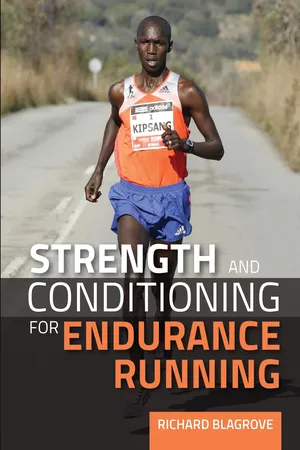![]()
1 | UNDERSTANDING YOUR NEEDS |
To appreciate the underlying reasons why strength and conditioning training techniques are effective for endurance runners, it helps to have a basic understanding of endurance running physiology and biomechanics, Based upon the physical qualities that underpin endurance running and the risk factors that contribute towards injury, a set of suitable assessments can then be selected. These will allow you to identify your own strengths and weaknesses so you can tailor a training programme around your own individual needs. The opening section of this book aims to introduce basic scientific concepts associated with strength training, conditioning and endurance running before presenting a series of simple assessments.
![]()
CHAPTER 1: INTRODUCTION TO STRENGTH AND CONDITIONING
WHAT IS ‘STRENGTH AND CONDITIONING’?
Twenty years ago the term ‘strength and conditioning’ (S&C) was virtually unheard of, let alone an important element in the physical preparation of sports performers. As standards at an élite level have improved, investment into understanding the science that underpins performance has also increased. Consequently, over the last decade or so, the value of specialist sport science support has begun to be recognized, and S&C has developed into its own industry. Despite the modern professionalism of élite sport, the knowledge and experiences of specialist coaches working with full-time athletes is rarely filtered through to recreational sports performers and young athletes, who would also benefit from a more holistic approach to their sports preparation.
S&C is associated with any training methodologies that enhance the physical preparedness of athletes for their sports training and performance. This means that any training that isn’t directly set by the technical sports coach is considered S&C. In a broad sense, S&C has three primary goals: to improve performance, to improve the capacity for training, and to lower the risk of injury.
To improve performance: The training techniques described in this book are likely to result in a number of adaptations to the nervous and muscular systems, which will directly enhance your running performance. These include improvements in your ability to generate force with each stride, more effective use of elastic energy from tendons, and a more efficient running style.
To improve the capacity for training: An indirect benefit of additional physical training is that you will be able to tolerate a greater volume of running. Without a foundation of general athleticism, robustness and physical competence developed through S&C activities, it is very difficult to tolerate progressively higher loads of training over a long period of time.
To lower the risk of injury: Due to the high volumes of repetitive loading on the body and on the joints of the lower limb in particular, it is no surprise that endurance running has a high prevalence of over-use type injuries. Placing load through a tissue that is vulnerable to injury using specific strengthening exercises will result in improved tolerance to repetitive stress. Reducing injury risk also indirectly results in improved performance, as less training time is lost through being side-lined with an injury.
Education
An often forgotten objective of S&C is to educate athletes and their coaches on the importance of supplementary physical training. If, like many, the concepts and exercises addressed in this book are new to you, it is important that you understand why they are valuable to your running performance, and how they should be correctly carried out. Hopefully in this way, your ‘buy-in’ and engagement with an S&C programme will be much better. Improving awareness of S&C for young athletes is also particularly important both in terms of maximizing their potential and establishing good habits.
Strength and conditioning (S&C) involves any physical training activities outside of your running programme. Strength training has been shown to improve running performance and reduce the risk of getting injured. Improving basic movement skills and physical capacities will also allow you to tolerate higher volumes of running in the future.
WHAT IS ‘STRENGTH TRAINING’?
Many runners and their coaches will often associate the term ‘strength training’ with muscle-bound men pumping iron in the gym and grunting loudly! This obviously isn’t the outcome that an endurance runner wants, and neither does it have to be.
‘Strength’ is loosely defined as the highest amount of force that a muscle group can produce under specific conditions. Fundamentally, we all require a basic level of strength simply to move around and complete everyday tasks. Everything we do is underpinned by the ability of specific muscles to produce force during a co-ordinated movement. So if we want to start moving quickly, as when we run, we need the capacity to be able to produce a high level of force rapidly through this movement pattern. Running speed then ultimately is directly related to the amount of force you are able to produce against the ground during a short period of time, so if you want to learn how to run faster there is a logical reason to make your running muscles stronger!
The ‘Specificity’ Trap
The key phrase contained in the definition of strength above is that force is always expressed under ‘specific conditions’. This means that just because one person shows exceptional strength in a gym exercise, it doesn’t mean that they will be strong on a different skill, or, more importantly, be able to express force well during running. So strength is always specific to the movement pattern we are expressing force in, but also the speed and direction we are developing the force. With that in mind, it is important that when you select exercises to improve your strength, they carry a degree of ‘specificity’.
Being specific doesn’t mean simply replicating or mimicking the running action, but selecting the right tool for the job. Just because an exercise doesn’t resemble the running action, it doesn’t mean it is useless. In fact you’ll find that many of the exercises contained in the chapters of this book look nothing like running. However, each provides a specific overload to a physiological system or area of the b...
